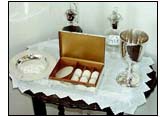American Catholic Press
16565 S. State Street, South Holland, Illinois 60473
|
||||||||||||||||||||
|
|
||||||||||||||||||||
|
||||||||||||||||||||
by Father Michael Gilligan As reported in Parish Liturgy (July, 1984), Bishop Ferrario of the Diocese of Honolulu asked all the parishes in his diocese to implement one aspect of the Order of Mass, which went into effect in 1970. His directive made it clear that the congregation is not to kneel down after the Lamb of God. While Communion is being distributed, the people remain standing, as one body, just as they do during the Gospel. When people return to their place, they continue to remain standing. This is a universal requirement, for the whole Catholic Church of the Latin Rite. Bishop Ferrario’s reminder has been supported
by several recent developments: a statement of Father Ronald Krisman,
a column by Father John Dietzen, and an article by Carmen Vinella.
Here is a brief review of each of these contributions to liturgical
renewal. In October, 1992, the annual meeting was held of the Federation
of Diocesan Liturgical Commissions (FDLC). These people are the members
of liturgical commissions set up in the dioceses of the United States. At this meeting, Father Ronald Krisman was present;
in 1992, he was still the director of the secretariat for the Bishops’ Committee
on the Liturgy. The FDLC
was involved in a discussion of the merits of standing or kneeling
during the Eucharistic Prayer. In speaking to the group, Father Krisman Father John Dietzen is the author of a nationally syndicated column, “The Question Corner.” In a recent column, Father Dietzen responds to some American tourists, who noticed while visiting Europe that no one knelt at any time during the Mass. Father Dietzen says that these people were following the general law of the Church, regarding postures during the Mass. He says that regulations on this topic are not difficult. The congregation is to remain standing from the Prayer over the Gifts to the end of the celebration. Exceptions, he says, are that the people should sit after Communion if there is a time for silent prayer; the people should “kneel at the consecration unless prevented by lack of space, large numbers, or other reasonable cause” (General Instruction of the Roman Missal, 21). In 1969, says Father Dietzen, the American bishops introduced an adaptation of this rule for the United States; they said that the congregation should kneel after the Holy, Holy, then stand after the final Amen of the Eucharistic Prayer (Appendix to the General Instruction, 21). As Father Dietzen points out, regulations for the whole Church,
except for the local adaptations, Carmen Vinella is the director of the Liturgy Office in the Diocese of Oakland California. In the November, 1994, issue of Modern Liturgy, Vinella provides some of the catechesis asked for by Father Krisman. She explicitly refers to the 1992 meeting of the FDLC. She quotes the Liturgy Constitution of the Second Vatican Council, promulgated in 1963: Liturgical services are not private functions, but are celebrations of the Church, which is the “sacrament of unity,” namely, the holy people united and ordered under their bishops. Carmen Vinella says that we are faced with a challenge, namely, to make the Mass a genuine prayer of the community. She says that thirty years have passed since the Second Vatican Council; however, we are now only beginning to understand its documents fully. We are only beginning to appreciate the meaning of the Mass. For example, people are coming to understand their important role as members of the congregation, through �actions, gestures, and bodily attitudes� (Constitution, 30). Through this kind of participation, we make a contribution to the liturgy. As Father Dietzen does, Vinella cites paragraph 21 of the General Instruction. She says it is clear that everyone should remain standing during the distribution of Communion. She also quotes Gabe Huck, a well-known author: Standing by all] puts those who have finished the Communion procession and those who wait to join it in unity with those in the procession. It gives a communal and public meaning to the whole time (The Communion Rite at Sunday Mass, 85). In accord with the General Instruction, Vinella recommends using bread and wine consecrated at the same Mass for Communion, rather than bread from the tabernacle. Such a procedure, she says, puts emphasis on the communal character of the Eucharist. How did Vinella implement in her diocese this requirement of standing? She says that her liturgy office studied Church documents and other literature before they did anything else. In this way, they accepted Father Krisman’s suggestion to do their best to implement the Church’s intention. After their study, the liturgy office started to teach people to stand all during Communion at ordinations and at the Chrism Mass; they wanted to reach the clergy first. Before each Eucharist, a priest or someone else told the people that they should stand during Communion, especially to emphasize the unity of the Church during the procession. The Master of Ceremonies did the same thing for the concelebrating clergy. At each celebration, after Communion, there was time to sit down and pray in silence. During Mass, some people knelt down after the Lamb of God; some remained standing. Gradually, more and more people stood up. It is not an easy change, says Vinella. Fortunately, her bishop has been helpful; he has encouraged clergy and people to stand all during the Communion Rite. Vinella’s liturgy office distributes a monthly newsletter to her diocese of Oakland. In that newsletter, she included articles about standing during Communion. Some priests called the office, to ask for more information; she told them of the pertinent Church documents and of Gabe Huck’s book, The Communion Rite. St. Francis de Sales was the cathedral church of the Diocese of Oakland for many years. This parish, Vinella points out, long maintained the tradition of standing during Communion.. In a sense, the people were accustomed to the practice; it seemed normal to them. In October, 1993, St. Francis merged with a nearby community, St. Mary’s. Now, there is a need for new instruction of the faithful. Carmen Vinella says that if we truly have faith that “we are the Body of Christ receiving the Body of Christ,” we will come to see the liturgy as a common act. We have to keep this perspective living in our hearts.
|
||||||||||||||||||||

 suggested
that the question of standing during the entire Eucharistic Prayer
(not just during the Preface) be left to the people who were working
on the new edition of the American sacramentary. Instead of discussing
standing during the Eucharistic Prayer, said Father Krisman, liturgy
commissions should do their best to encourage standing by the whole
congregation during the distribution of Communion. Diocesan liturgy
offices should concentrate their efforts on teaching people why it
is important to stand during Communion.
suggested
that the question of standing during the entire Eucharistic Prayer
(not just during the Preface) be left to the people who were working
on the new edition of the American sacramentary. Instead of discussing
standing during the Eucharistic Prayer, said Father Krisman, liturgy
commissions should do their best to encourage standing by the whole
congregation during the distribution of Communion. Diocesan liturgy
offices should concentrate their efforts on teaching people why it
is important to stand during Communion.